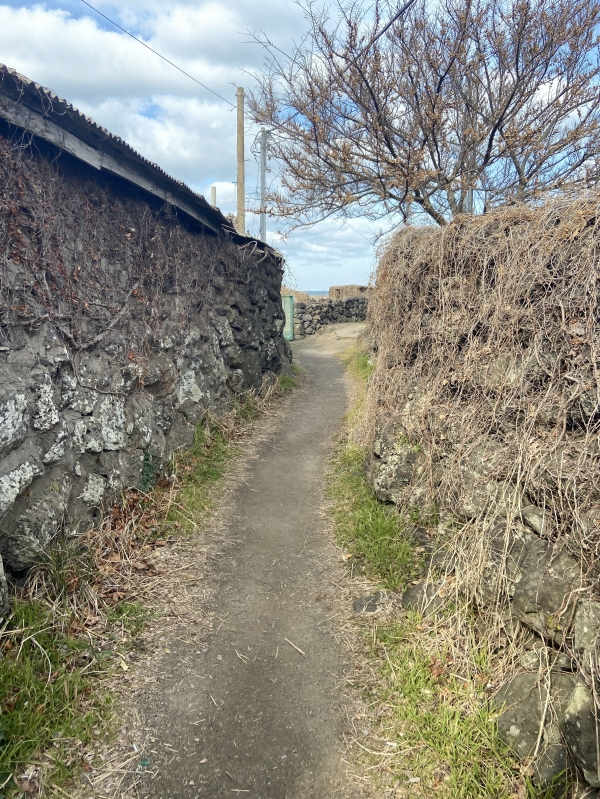
Dubbed as “Hawaii of Korea”, Jeju Island, located in the Korea Strait, is the largest island in South Korea. The island was formed by an underwater volcanic eruption two million years ago and is packed with natural world heritage sites as well as museums and outdoor activity spots that make Jeju a popular tourist destination.
Contrary to the numerous blog posts on the internet, Jeju gets wildly cold in the winter. During a recent visit, the temperature rarely went below zero nor did it go above ten, which was moderately warm compared to mainland Korea. It is the strong wind from the cold sea that makes the ears go cherry red and the nose run with frosty snot. Although mountainous in the center of the island, the land is generally flat around the coastal outskirts, and with nothing to block the unforgiving wind, one can easily imagine its severity. Maybe not so agreeable for travelers, the strong wind, on the other hand, makes for an ideal location for wind power plants, which are placed all over the island and especially in the 20th Jeju-Olle (Jeju-Olle is a name for Jeju’s designated hiking trail that is divided into twenty-one subsections and goes around the island.) Taking advantage of its geographical features, the Korean government has increased Jeju’s renewable energy by 50% and is en route to making the entire island carbon-free by 2030.
The word Olle in Jeju dialect means “narrow alleyways”, and its first-ever section (First Olle) was built in 2007 by a Korean Journalist, Seo Myong-suk, who was inspired by the Camino de Santiago. Hiking along Olle is a good way to experience the true ins and outs of Jeju and its culture. Along the trail are well-thought-out Olle mascot flags and arrow signage that guide hikers without the need to frantically search through a map. This primitive navigation system added an element of adventure and excitement to the hike that, at times, can get mundane; it was an excitement brewed from the possibility of taking the wrong path, which is somewhat of an obsolete concern nowadays. At the start and the end of each sub-section, there is a small stall in the shape of Olle’s mascot horse inside of which is a unique stamp one can use to mark the completion of a section. Occasionally, there is also a gift shop that sells Olle mascot keyrings among many other souvenirs that are absurdly overpriced, but far too tantalizing to forgo the opportunity to make an impulsive and unwise purchase. In all fairness though, all souvenirs are made with eco-friendly materials, and most of the profit goes into trail maintenance. Hiking may not come with the modern convenience of a rental car, but that convenience is the very reason it prevents travelers from discovering hidden gems that lie in the details. The trail is purposefully designed to go through all the small and seemingly insignificant towns, and while doing so, one is met with warm greetings from the locals; elderlies strolling down the street with their walking sticks; and sometimes, furious dogs barking over the fence trying to appeal their existence. The trail also takes the hiker deep into the forest; right under the wind power plant; the middle of a rapeseed field too yellow as if to glow brightly even in the dark; magical places secretly hidden under the cover of nature patiently waiting to be unveiled.
Speaking of magical places, Seongsan Ilchulbong also known as the Sunrise Peak is one such place that always makes it on the list. Located on the easternmost part of the island, the Sunrise Peak was formed by an underwater volcanic eruption about five thousand years ago. It is “designated as a UNESCO World Natural Heritage site and it is worth preserving permanently as a natural heritage of humankind.” It is also widely known as a popular sunrise sighting spot on New Year’s Day. The inevitable consequence of popularity is the commercialization of the surrounding area, and the Sunrise Peak was no exception. Right next to the entrance, on a place best for viewing the entire Peak from the ground, is a Starbucks; right next to Starbucks is yet another café followed by a never-ending trail of a miscellaneous assortment of stores. Loud music playing on the street and bustling cars going in and out of the parking lot distract one’s attention from appreciating the phenomenal view that lies ahead. Its beauty is arguably best appreciated from a distance along the coastline of Gwangchigi Beach leading to the Sunrise Peak. Humorously, its official name on Google Maps is the “beach with Seogsan Illchulbong view”. The Sunrise Peak protrudes from the rest of the island and its immediate surrounding is a boundless cerulean sea. From Gwangchigi Beach, one can view a quite aggressive cliff, its color British khaki with a smudge of creamy white. The Sunrise Peak standing in solitude holding a silent vigil over the eternal voidness of the sea seems to share a lot of similarities with Mont Saint-Michel in France.


